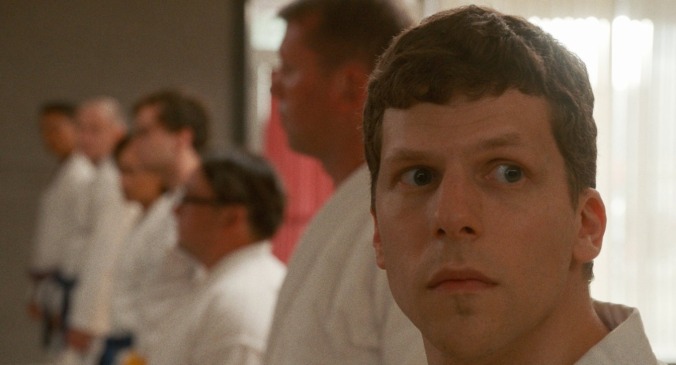Jesse Eisenberg learns The Art Of Self-Defense in an arch, funny karate satire

When Jesse Eisenberg was younger, the comparisons between his performance style and Woody Allen’s were unavoidable: neurotic overthinking, a hesitant speaking style, a habit of slipping nerdy wisecracks in between his nervous stammers. Inevitably, he did appear as an Allen surrogate, but as Eisenberg’s career proceeds (and Allen’s crashes and burns amid allegations of sexual assault), some of Eisenberg’s most interesting work places his familiar persona in contexts far more extreme than dramedies-of-manners like Café Society, The Squid And The Whale, or Louder Than Bombs. He’s good in all three of those movies, but he’s even more distinctive navigating the zombie apocalypse in Zombieland, mincing through a Zack Snyder hellscape as a twitchy Lex Luthor, or playing a stoner Jason Bourne in American Ultra—movies where his presence in a leading role feels like part of a great, weird joke.
Eisenberg’s starring role in The Art Of Self-Defense isn’t quite so genre-friendly, but it is similarly extreme, designed to push the limits of a typical Eisenberg character even as it indulges his familiar mannerisms. Casey (Eisenberg) is a lonely office drone who speaks with a meek, hushed timbre. The alienation he feels at home (where he talks mostly to his little dog) and at work (where he’s unable to make casual conversation with his alpha-complainer coworkers) is physicalized when a random attack leaves him hospitalized, and even more fearful of the world around him. During his resulting medical leave, Casey decides to combat his fear, enrolling in karate classes at a modest-looking local dojo under the tutelage of a conspicuously unsmiling sensei (Alessandro Nivola).
It’s around this point that writer-director Riley Stearns makes it clear: Casey isn’t the only one in this movie whose dialogue will be intentionally stilted in a deadpan parody of human speech. Every member of every class at the dojo sounds like a nerdy child, in thrall of their sensei and thrilling to the color-coded belt system. When Casey receives his yellow belt, he swells with barely-concealed pride. He wishes it was considered socially acceptable to wear karate belts in public, in everyday life.
Stearns’ comic style makes it clear that The Art Of Self-Defense will not follow Casey on a straight line on the path of belt acquisition. Nor will he pursue a conventional romance with Anna (Imogen Poots), seemingly the only female student and only female instructor at the dojo. (As such, she’s consigned to perform her cool-down exercises in the “women’s locker area,” actually just a boiler room). What the movie does instead is difficult both to describe and to analyze; the non-spoiler outline is that the stern sensei takes a shine to his not especially gifted but extremely teachable pupil, who discovers some secrets about the inner workings of the dojo.
Even before the tension ratchets up, The Art Of Self-Defense seems to be taking aim at the cultish lure of toxic masculinity. But Stearns’ precise, controlled style sometimes belies the broadness of his targets. Casey isn’t just an alpha-male’s caricature of a beta-male; he’s a thirtysomething guy who earnestly answers “adult contemporary” when asked about his favorite type of music. Nivola, meanwhile, is playing the type of man who then explains that the only type of music worth listening to is metal. That is to say, both of these parts, as written, are distillations more than fully believable people.
The movie is clearly set at some point in the past: answering machines and old-fashioned camcorders are vehicles for plot points, while computers are present, but not omnipresent. This unspecified time period both explains its characters’ casually dopey ideas about gender, manliness, and physical confrontation, and, at times, neutralizes them. Stearns doesn’t appear to be poking cheap fun at a particular bygone era, but he does use his setting as an excuse to make the characters feel slightly more alien, and their story more like an exercise. It’s hard to extract much real satire from a movie that sometimes feels like Stearns self-consciously attempting push an amalgam of The Foot Fist Way and the “Rex Kwon Do” scenes in Napoleon Dynamite into more overtly malevolent territory.
Yet The Art Of Self-Defense is funnier than those secondhand comparisons imply. The sheer confidence of Stearns’ filmmaking keeps caricature at bay, as do the actors, who are tasked with putting human faces to vaguely satirical ideas—and largely succeed. (Poots is especially good at conveying both a simmering rage at her gendered treatment and a burning desire to prove herself.) Eisenberg is excellent as usual, utilizing his gift for adding range to movies that might have otherwise stayed within a narrow scope. Here, he fits some genuine heartbreak into the movie’s arch architecture, whether scolding his dog or breaking down into frustrated, self-loathing tears when he fails to dominate a bully. In a movie that often observes male dysfunction with some ironic distance, Eisenberg brings the satire closer to the bone.